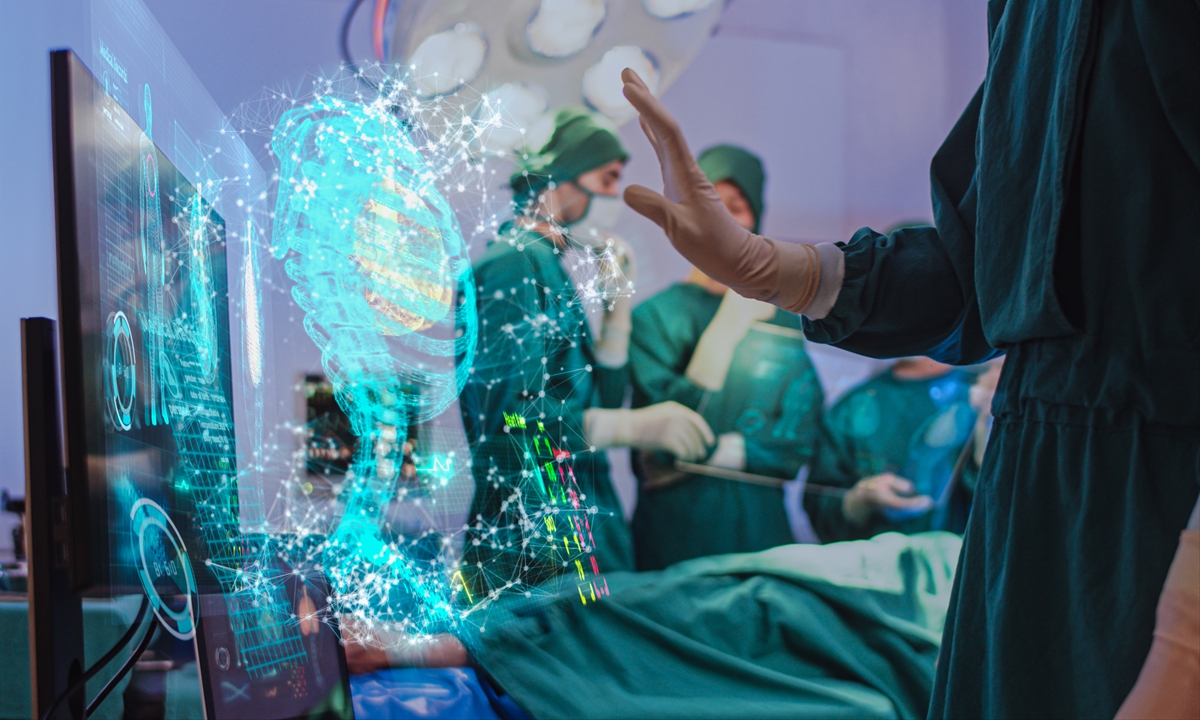
A concept photo of AI in healthcare Photo: VCG
The development of artificial intelligence (AI) in China has made progress since early 2023, as the revolutionary technology is increasingly used in almost all industrial and service segments, although not yet on a large scale.
According to some international investment organizations, by 2030, AI technology will contribute about $8 trillion to China’s GDP, compared to about $5 trillion in added value for the U.S. economy.
Huawei Technologies’ research and innovation prowess in leading AI exploration and integrating its AI solutions into a wide range of industrial fields in China has made a difference. For example, four Chinese automakers, based in Hefei and Wuhu in Anhui Province, Beijing and Chongqing respectively, were selected by Huawei to produce smart electric cars connected to the Internet and equipped with Huawei’s latest AI software. Their vehicles are now the best-selling vehicles among Chinese consumers.
Despite the most ruthless crackdown and repression by the United States, Huawei has not given in or capitulated, but has focused on local innovation. The tech giant has become the leading supplier of advanced AI chips after Washington imposed export restrictions on Nvidia GPU processors. Currently, Huawei’s core technology trains AI models 1.1 times faster than popular GPUs.
Huawei’s proprietary Pangu AI models address a multitude of industry-specific needs as the company is committed to helping Chinese enterprises and governments at various levels use large Pangu models to solve problems and increase efficiency in ways never seen before. Currently, Huawei’s Pangu AI models are proliferating to cover almost every aspect of the national economy, including the Pangu mining model, Pangu manufacturing model, Pangu drug molecule model, Pangu port model, Pangu railway model, Pangu telecommunications model, Pangu financial model, Pangu government model, Pangu meteorology model, and many more.
As China makes new efforts to vigorously develop new high-quality productive forces, Huawei’s Pangu series of AI solutions will demonstrate its great capabilities.
The Pangu mining model has been applied in eight coal mines in China. A single model can support more than 1,000 coal mining sub-scenarios, including digging, equipment control, transportation, ventilation, coal washing, etc. It can build safer and smarter mines, which can operate efficiently with a small underground crew or even without an underground crew at all. As a result, mining efficiency has greatly increased.
The Pangu manufacturing model, pre-trained on data about parts and components, business processes, and rules from Huawei’s own production lines, is able to accurately understand intentions. By calling the Huawei OptVerse AI Solver plugin, the Pangu manufacturing model can develop a 3-day production plan in just 1 minute.
Pangu’s railway model can accurately identify 67 types of freight cars and more than 430 types of defects detected on railway tracks and freight cars. The model can quickly analyze millions of images captured by the railway TFDS system and filter out 95% of the images that are free of defects. In this way, train inspectors can focus on the remaining images, which helps them improve both efficiency and accuracy.
Pangu virtual human model supports model generation and control, trained with 200,000 hours of video and audio data. Model generation and control make it easy to create virtual humans for online education, entertainment, live broadcast, meetings and more.
In the past, developing a new drug took up to 10 years and was very expensive. Now, Huawei’s Pangu molecular model can accelerate the discovery of lead compounds from several years to one month, reducing drug R&D costs by 70%. For example, using this model, a team led by Professor Liu Bing from Xi’an Jiaotong University discovered a super-innovative new antibiotic, the first antibiotic to be discovered in 40 years with novel protein targets.
The Pangu weather model is the first AI model to surpass the most advanced numerical weather prediction method in terms of accuracy. The prediction speed is much faster. In the past, predicting the trajectory of a typhoon in 10 days required 4 to 5 hours of simulation on a high-performance cluster of 3,000 servers. Now, the Pangu model can do it in 10 seconds and with more accurate results.
The Pangu government model has been trained on more than 200,000 government data records, covering government policy documents, government encyclopedia knowledge bases, government hotline data and other common knowledge, so it has deep knowledge of government policies, regulations and government service processes.
The Pangu financial model, pre-trained on large datasets containing data on bank policies, procedures, and case studies, can automatically generate appropriate workflows and service guides for bank tellers based on customer service requests. This helps them handle service requests more efficiently. Essentially, the Pangu financial model has given every bank employee their own personal intelligent assistant.
Huawei has just introduced its latest AI innovations to enhance the capabilities of telecom networks at the case, process, and system levels, significantly accelerating network intelligence. “We believe that network innovation in the 5.5G era covers two aspects: AI for networks and networks for AI,” the company said in a statement.
Huawei is the leader in 5G mobile networks. Huawei has pioneered the application of network intelligence technologies to the field of data communication. Today, AI-based high-speed mobile network solutions accurately meet the needs of intelligent networks and, more importantly, boost AI training and maximize the transmission capacity of intelligent computing.
The company’s 5.5G converged WAN, featuring high throughput, high elasticity and highly guaranteed performance, provides intelligent transmission capacity, enabling intelligent defense and increasing network operational efficiency by 100 times. As China’s mobile networks are constantly being upgraded, the scale of connections and connection speed will enable more innovations and real usage scenarios.
It is true that Huawei, despite the crackdown by the US government, has made miraculous breakthroughs in areas ranging from mobile networks, high-end chips, operating systems to artificial intelligence, and it took the company just 10 years to do what it took the US 30 years to achieve.
The author is a staff writer at Global Times. bizopinion@globaltimes.com.cn


